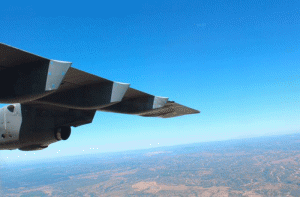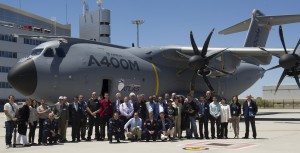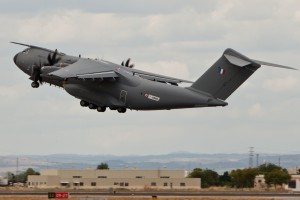2013-06-17 By Robbin Laird At the recent Trade Media Briefing 2013, journalists who attended were given the opportunity to fly the aircraft for more than an hour. Francis Tusa, the well-known British journalist and hardly a Euro hugger, underscored what we all felt:
The lack of noise within the aircraft was noticeable compared to the C-17, C-130 or other aircraft. The seats are more comfortable as well. I did not hear the engines start up, and so was surprised when the aircraft took off. And then the incredibly rapid takeoff demonstrated its capability to lift from very, very short fields. The plane had a very stable performance in flight. And all of this in a very large cargo aircraft.
The A400M features C-130-like ability to use a wide variety of airfields with the capability to carry oversized loads of the sort that the C-17 currently carries.

The aircraft will be able to deliver equipment and personnel closer to the point of attack than the C-17 with C-17 type loads.
It will not be difficult to see how this aircraft will initially be used.
In the current Mali operation, the French had significant challenges in delivering the capability necessary for their forces. When the A400M many years ago was first thought of, lift was considered somewhat equivalent to a truck or a greyhound bus.
With the last decade of experience and the revolution in air dropping, the air lifter is an integral part of the kind of expeditionary logistics, which insertion forces clearly need to operate with for 21st century operations.
In my colleague’s reporting from Mali, the French military made it clear to her that they were eagerly waiting for the A400M to join the fleet in order to facilitate the kind of operation which Mali represented. As Murielle Delaporte underscored about the Mali operation:
Air support has been crucial in the areas of more intense engagement. Forward air controllers or FACs were important members of the ground forces. And air assets –Air Force (fighters), Army (helos) and Navy (Atlantique 2) – have been drawn upon in the operation. More generally, and as far as the air component goes, one should also stress that the demands on the old tactical transport aircraft Transalls or the C-160s are very high. This would be a good time to have the new A400Ms in play. French Air Force officers all agree that it will be beneficial in the near future to have a plane which could fly straight from France and have the capability to land on the short, tough airfields characteristic of the Mali operation.
The logistics side of the Mali operation was inextricably intertwined with the combat forces in the combat operation.
Murielle Delaporte, based on interviews with the French forces in Mali, has emphasized that the French are re-inventing the Caravan concept but in the context of 21st century operations. They are deploying into combat areas the forces they need but correlated with the support they need as well.
They are not creating mobile Walmarts that need to be defended. And in this effort, various transport means are being used, including convoys (on which she travelled for several days in Mali) as well as airlift of various types.

To gain a sense of how the A400M would be used in the future with the Mali operation in mind, Airbus Military’s Damien Allard, the Market Development Manager for the A400M, has put together a briefing, which he recently presented at a press conference.
At the heart of the approach is the capability of the aircraft to carry C-17 type loads with C-130 type agility. The A400m combines an ability to carry outsize and heavy loads that cannot fit into current tactical airlifters and be able to deliver those loads on soft, short, and austere areas where current strategic airlifter cans not.
According to Airbus Military, the plane can deliver up to a 55,000-pound or 25 ton payload onto as short an airfield as a 750 meter or 2500 foot low grade airstrip.
The range of the aircraft will allow it to fly directly from France to do the resupply effort and land directly onto remote airfields, creating a very different type of transit link, one between the supply “warehouse” and the engaged force. The key is to deliver equipment to the point of need for the supply points, not necessarily located in the combat zone or country. This allows reduction of transit time, and enhanced security of supply.
At the heart of the evolving concepts of expeditionary logistics is the concept of providing support integrated within combat forces, without having to stockpile equipment to support “forward” deployed forces. The notion of the “front” and “rear” is eroded by the expeditionary logistics concept.
The A400M fits right into this concept. The A400 M will bring the capability to the French forces of delivering heavy and outsize loads directly from France or from other airfields in the region to unpaved airstrips in Northern Mali such Tombouctou, Gao, or Tessalit.
According to Damien Allard: “The A400M can airlift all the equipment in use for ‘Operation Serval,’ including those which were either sealifted through slow Ro-Ro ships or airlifted through costly strategic airlifters.” The first A400Ms are being delivered this year to the French and Turkish forces.
Clearly, the European forces need an upsurge in lift capabilities. The program has been contracted between a European agency called the Organization for Joint Armament Cooperation or OCCAR and Airbus Military, which guarantees a stable, buy of the aircraft. Beyond the core buyers – the UK, France, Germany, Turkey, Spain, Luxembourg, and Belgium), the first export customer is Malaysia.
What this means is that the signers of the OCCAR contract are obligated to buy the core purchases even if they decide to reduce the number in their own inventory from the initial order.
Contract stability among multinational partners in the program is a crucial element of launching such a program in challenging financial times. The A400M is clearly a 21st century aircraft and part of the multi-mission revolution generated by the small number of multinational programs, which are re-baslining 21st century capabilities. Whether it is the A400M or the F-35, each platform is part of a fleet and is designed to operate as such. https://sldinfo.com/defense-security-publications/
Some of the characteristics of such a fleet are building in logistics from the ground up. Common serial numbers or UIDs are built in. These common markings enable a global logistics management effort. The prime contractor manages the global supply chain to build the aircraft and manages the data on parts performance to ensure improvements in the supply chain as operational experience is gained with the aircraft.
Multi-national training is a core focus of the A400M and the F-35, and this common training facilities cross-fertilization of ideas of how to use a common fleet. There is an opportunity to apply the user group concepts pioneered by programs such as the Rover or the C-130 and to apply the inputs from user groups to drive further development of these 21st century programs rather than developing the program based on the desires of procurement agencies or engineers.
Clearly, global reach is enabled by each participant in the program getting economies of scale on parts, surge capabilities, and the possibility of cross learning on con-ops. The A400M will re-define airlift with its capability to bring large loads into close proximity to operational forces.
This does not mean that the market for other lift aircraft simply vaporizes over night. The core concept which I developed for understanding the impact of 5thgeneration aircraft is the re-norming of air operations, whereby the new aircraft reshape how air operations are done, and how legacy aircraft are used and how new capabilities get defined and added over time.
The A400m is part of re-definition process for airlift.

C-17s are no longer being built. This means that the C-130J and the upgrade market of the C-130s will remain part of the picture of some time to come. Embraer is promising to launch a new lift aircraft into the mix as well. The market by 2030 is certainly going to be a mix of these aircraft, but the capabilities of the A400M will be obvious from how its users deploy the aircraft. And in this market and is many parts of the military market, imitation is the highest form of flattery.
A suggestion of how the mix might play out came from a discussion with a senior editor of an Asian defense journal. M. Ghazemy Mahmud, the editor of the Malaysian based Asian Defence Journal:
A core reality is that the A400M will be used with our C-235s and C-130s for a long time. In effect, a task force approach will be put in place. Malaysia has C-130Hs which is relevantly new airlifter and the Air Force is very pleased with this aircraft. It will be upgraded over time, but the C-130J will not be bought because of the availability of the A400M. Although the Malaysian Air Force likes the C-17, it is too expensive to buy and to operate for them. The A400M is a better choice for them, and will shape a new approach to the use of the overall fleet.
In short, the A400M, which will appear at the forthcoming Paris Air show and not only fly, but also have the first French aircraft on display, will be a key contributor to 21st century air capabilities.
And these capabilities are part of what I like to call the 3 Ms: multi-mission, maintainable and high technology manufactured.
In today’s world, the acquisition of aircraft in financially stringent environments favors multi-mission platforms. The U.S. and allied air forces are buying less aircraft and a smaller variety of aircraft. The expectation is that the aircraft purchased will do more than their core specialty. With regard to maintainability, new platforms are built with a significant amount of attention to how to enhance their ability to be maintained over time. When platforms were built thirty years ago, logistics support was an afterthought. Now it is a core element of determining successful outcomes to the manufacturing process.
The final M is manufacturability. Briefing slides and simulations are not the same thing as a finished good of high quality and of high reliability. Here you need a trained workforce, good engineering practices and an ability to deliver a product of high quality and standards. It is challenging to build new systems and not every manufacturer is created equal. And a core element of today’s manufacturing systems is the challenge of managing extended supply chains. And these supply chains are subject to disruptions and the need to manage those disruptions.
In short, the Three M’s – Multi-Mission, Maintainability and Manufacturability – are key elements of shaping 21st century air capabilities. Flexibility, agility, reliability and performance are highly interactive elements for building viable platforms and systems for the years ahead and the A400M is a core example of 21st century trends.
For earlier A400M stories focusing on the TMB 2013 experience see the following: https://sldinfo.com/the-a400m-in-seville-may-2013/ https://sldinfo.com/airbus-military-seville-may-2013/ https://sldinfo.com/an-update-on-the-a400m-may-2013/ https://sldinfo.com/flying-the-a400m/
In the video at the top, the old is seen working with the new as the venerable C-160 is seen refueling the A400M in flight. For a great video highlighting the flying qualities of the A400M see the following video which highlights a formation flight in 2012.
.

